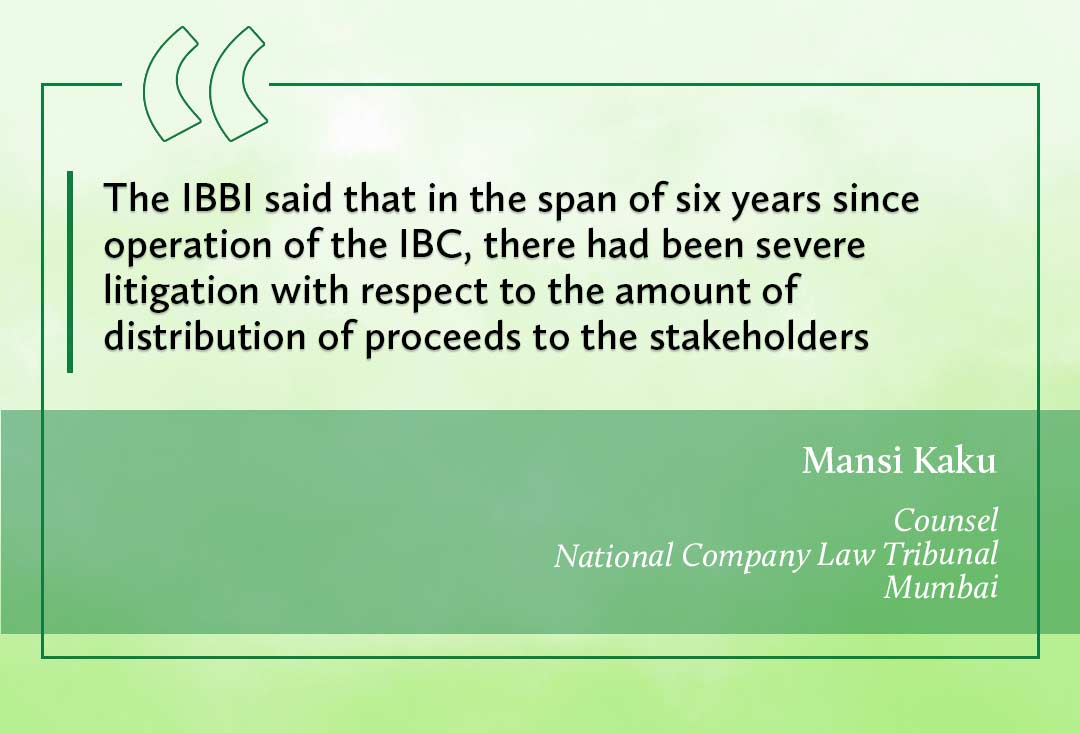National Company Law Tribunal Mumbai counsel Mansi Kaku explores crucial changes that the insolvency board seeks to better align the corporate insolvency resolution process and overcome significant challenges
It is often said that, in order to meet the changes, advancements and circumstances of society, the law must evolve with changing times.
Under the law for insolvency resolution in India – the Insolvency and Bankruptcy Code, 2016 (IBC) – a regulator called the Insolvency and Bankruptcy Board of India (IBBI) has the power to make regulations for a mechanism for the disposal of assets under the code. The idea and the foundation for the introduction of the IBC is that time is of the essence, and that time value has to be preserved to drive the resolution and liquidation process of a corporate debtor (CD).
The National Company Law Appellate Tribunal (NCLAT), in the case of Binani Industries Limited v Bank of Baroda & Anr, has expressly set out that the IBC’s first objective is resolution of the CD, the second objective is maximising the value of the assets of the CD, and the third objective is the availability of credit, balancing of interests and promoting entrepreneurship.
The IBBI is empowered under the IBC to make regulations for better implementation and achievement of the objectives of the code. As it can been seen from the records of the past six years since the commencement and operation of the IBC, in the event that stakeholders have expressed concerns or difficulties, or pursuant to court rulings on certain fundamental issues, the IBBI has played a vital role in fostering trust and, from time to time, proactively made changes and amendments when required to the code, as well as its regulations.
The discussion paper

Counsel
National Company Law Tribunal Mumbai
On 1 November 2023, the IBBI published on its website a discussion paper for amendments to the existing IBBI (Insolvency Resolution Process for Corporate Process) Regulations, 2016 (the CIRP regulations), and invited comment and solicited feedback on its proposals from stakeholders such as: (1) CDs; (2) personal guarantors to a CD; (3) proprietorship firms; (4) partnership firms; (5) creditors; (6) interim resolution professionals (IRPs) or resolution professionals (RPs); (7) insolvency practitioner agencies; (8) insolvency practitioner entities; (9) academics; and (10) investors.
The important change proposed in the above-mentioned discussion paper is the structuring of a resolution plan. The IBBI said that in the span of six years since operation of the IBC, there had been several litigations with respect to the amount of distribution of proceeds to the stakeholders.
Because of this, the resolution plan of the CD does not get approved, the effective implementation of a resolution plan and takeover by resolution applicants gets hampered, and the entire corporate insolvency resolution process gets derailed.
This article briefly discusses the key changes proposed to the above-mentioned CIRP regulations in the discussion paper.
Insolvency resolution process cost (IRPC)
The IRPC includes: (1) the amount of any interim finance and costs incurred in raising such finance; (2) fees to be paid to an RP/IP entity/professionals; (3) costs incurred by an RP in running the business of the CD as a going concern; (4) costs incurred by the government to facilitate the insolvency resolution process; (5) amounts due to suppliers of essential goods and services; and (6) fees payable to the IBBI. The definition of the IRPC is found in section 5(13) of the IBC, and explained in regulation 31 of the CIRP regulations.
The CIRP regulations provide for fixing by the applicant/adjudicating authority (AA) of the expenses incurred by the interim resolution professional, and ratification of the same by the committee of creditors (COC), and also for fixing by the COC of expenses incurred by the RP.
The proposed amendments to the CIRP regulations suggest express provisions where the IRP must in each COC meeting: (1) apprise the COC about the operational status of the CD; and (2) take approval for all the expenses of the COC (proposed amendment No.1).
There may be times when the actual expense incurred by the IRP is more than the expense fixed by the applicant/AA/COC. Therefore, the insertion of proposed amendment No.1 will increase the visibility of the COC on the actual expenses of the CD, will also enable the COC to take informed decisions and will increase the accountability of the IRP.
Section 30(2)(a) of the IBC provides that the IRPCs are to be paid in priority over any other creditors of the CD. Section 53 of the code, which deals with the distribution of assets of the CD, provides that proceeds from liquidation assets shall be distributed in an order of priority where the IRPC and the liquidation costs paid in full get first priority.
It is settled law that the resolution plan of the CD should provide for: (1) payment of the IRPC in priority; (2) payment of debts of operational creditors; (3) payment of debts of dissenting financial creditors; (4) management of affairs of the CD after approval of the resolution plan; and (5) implementation and supervision of the resolution plan.
There are many rulings of the Supreme Court of India, and it has also been observed in the case of Jaypee Kensington Boulevard Apartments Welfare Association & Ors that beyond a shadow of doubt the process of consideration and approval of the resolution plan of a CD is essentially that of commercial wisdom of the COC and the scope of a judicial review remains limited within four corners of section 32(2) of the IBC for the AA, and section 32(1) read with section 61(3) for the AA.
On 6 November 2023, even the NCLAT, in ICICI Bank Limited v BKM Industries Limited, reiterated the commercial wisdom of the COC, and that it does not call for interference unless creditors belonging to a class being similarly situated are denied fair and equitable treatment.
Thus, proposed amendment No.1 is welcoming as it will be a beneficial provision in favour of creditors and will certainly preserve the intrinsic value of the CD and secure better returns for the creditors of the CD, and increase the onus of the IRP.
Meetings of the COC
Regulation No.18 of the CIRP regulations provides that: (1) when the RP considers necessary, he/she may convene a meeting; or (2) on a request received from the members of the COC, having at least 33% voting rights.
The proposed amendments to CIRP regulations provides that meetings of the COC may be convened as and when the RP considers it necessary, and makes it mandatory that the gap between two meetings of the COC should not be more than 30 days (proposed amendment No.2). This is one of the key proposed amendments in the discussion paper.
These mandatory provisions to conduct COC meetings will regularise the meetings and as a result make the process of management of the affairs of the CD, or the resolution process of the CD, more systematic. Regular COC meetings will result in and encourage all stakeholders to act quickly and efficiently, and this move is certainly appreciated.
Valuation methodology and report
The proposed amendment makes it incumbent on the RP to facilitate a meeting of the members of the COC with the registered valuer appointed by the RP. Additionally, before calculating the estimates of the fair value (as defined below) and liquidation value of the assets of the CD, and before finalisation of the valuation report, it makes it binding on the registered valuer to explain to COC members the valuation methodology (proposed amendment No. 3).
This amendment is put forward to reduce disputes raised by the COC with respect to the valuation methodology adopted by the registered valuer. An engagement between COC members and the valuer will give the COC members a platform to give their input, and will increase transparency in the process of valuation of the assets of the CD.
With this proposed amendment, the involvement of the COC will also increase.
Fair value in information memorandum
Currently, the prospective resolution applicant (PRA) who submits bids for the CD are not provided with the fair value, the liquidation value and the valuation report of the assets of the CD. However, on account of proposed amendment No.3, information pertaining to the valuation methodology will be available with the COC, and this will enable its decisions regarding PRAs and their eligibility criteria. Lack of information of the CD sometimes results in an increased workload for the NCLT and delays the resolution process.
Fair value means if the assets of the CD pursuant to marketing were to be exchanged on the date of insolvency commencement date between a buyer and a seller as an arm’s length transaction, and when the parties acted knowledgably, prudently and without compulsion, the estimated realisable value of the assets of the CD (fair value). Fair value is defined in section 2(hb) of the IBC.
The discussion paper provides that fair value of the assets of the CD should be made a part of the information memorandum prepared by the RP under section 29(1) of the IBC, and which contains details of the CD as listed in regulation 36 of the CIRP regulations (proposed amendment No.4). If the fair value of the assets is provided to the PRA, this will assist it to make informed decisions about the CD and thereby result in viable and better valued resolution plans prepared by the PRA. The proposed amendment No.4 brings in fairness and transparency.
Disposal of extension application
The timeline for the corporate insolvency resolution process is 180 days from the insolvency commencement date, or such other period that may be extended by the AA on an application made by the RP further to instruction from the COC. In case of failure to file a resolution plan within 180 days of the insolvency commencement date or other extended period, the AA is empowered to pass orders to liquidate a CD.
The AA is empowered to give extensions of 90 days at a time. The maximum time within which the process has to be completed is 330 days.
During the period from when the extension application is made by the RP and the adjudication by the AA of such extension application and receipt of the order (interim period), the RP is responsible to go on with CD operations and business. A clarification is proposed to be added in regulation 40 of the CIRP regulations providing that during the interim period the RP shall continue to discharge his/her duties (proposed amendment No.5).
Dissenting creditor minimum entitlement
The IBBI said in the discussion paper that structuring the resolution plan in two parts will enable the AA to first approve the resolution plan effectuating control by the resolution applicant so that inflow can take place and the CD may start functioning again, and the second part shall deal distribution among the various stakeholders. In case of any dispute or litigation, the disputed amount may be kept in escrow and be distributed after litigation attains finality.
Contents of the resolution plan are mandated and specified in regulation 38 of the CIRP regulations. The amount to be paid to financial creditors who did not vote in favour of the resolution plan shall be paid in priority over financial creditors who voted in favour of the plan, and this has to be mentioned mandatorily in the resolution plan.
It is proposed in the discussion paper that the resolution plan prepared by the prospective resolution applicant should be prepared in two parts, i.e., one part should explore inflow perhaps resulting in the CD becoming fully functional again, and the second part should deal with the distribution of payments to different categories of stakeholders (proposed amendment No.6).
The IBBI has suggested the two parts in the resolution plan, which will enable faster transition of distressed CDs to the prospective resolution applicant (who bids the highest and wins in the bidding), and thereby CDs can remain operational, without delays and much deterioration of the value of their assets.
Proposed amendment No.6 is a critical proposal in the discussion paper in relation to resolution plans, is definitely a well appreciated move, and will save time.
The proposals in the discussion paper aim to avoid closures of viable CDs or their business, and to expedite the liquidation process while maximising the value of CD assets and eventually achieving the objectives of the IBC.
Mansi Kaku is an advocate/counsel who regularly appears before Bombay High Court, City Civil Court and the National Company Law Tribunal in Mumbai with her chambers in the Fort area of the city. This article is for general information purposes only and not intended to be used for legal advice or to substitute professional advice.



























